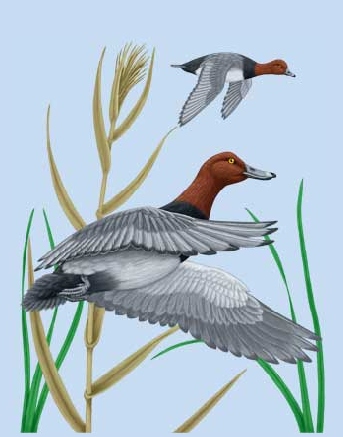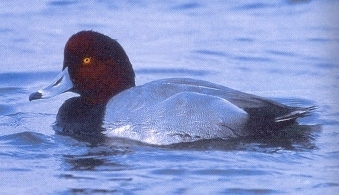|

Medium
diving duck, gray back and sides, black upper back, breast, rump, and
tail, and white belly. Head and neck are rufous-brown, and blue-gray
bill is black-tipped; eyes are yellow. Feeds mostly on aquatic vegetation.
Rapid direct flight with strong wing beats,
flies in V formation.
The male Redhead has gray upperparts and underparts, rufous head and
neck, black breast, rump, and tail, and
black-tipped gray bill.

|
REDHEAD
Aythya americana
ANSERIFORMES
Geese and Ducks (Anatidae)
Range
and Habitat
Breeds in the northern prairies of the U.S. and Canada and intermountain
marshes of the west. Spends winters mostly in Texas and Mexico. Nests
in marshes, open lakes, and bays; often winters on saltwater.
SOUNDS: "whee-uogh", "keyair", "rrrrr"
The Redhead was first described in 1838 by Thomas Campbell Eyton, an
English naturalist. Females regularly lay eggs in the nests of other
Redheads or other ducks, especially Canvasbacks.
A group of ducks has many collective nouns, including a "brace",
"flush", "paddling", "raft", and "team"
of ducks.
The Redhead has a large range, estimated globally at 5,100,000 kilometers.
Native to Guatemala, North America, and many nearby island nations and
territories, this bird prefers inland wetland or neritic and intertidal
marine ecosystems. The global population of this bird is estimated at
750,000 individuals and does not show signs of decline that would necessitate
inclusion on the IUCN Red List. For this reason, the current evaluation
status of the Redhead is Least Concern.

|